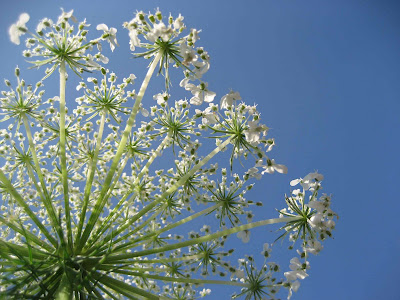
When carrots flower, they grow umbels that look like fireworks from the bottom, lace from the top. How often do they get to flower, though, since the biennials only flower the second year and are harvested the first. No matter, they look just like Queen Anne's Lace, which you've most likely seen growing somewhere recently. It grows on the roadsides, the train tracks, the edges of parking lots, wielding intricately organized galaxies of tiny flowers, one tiny dark flowers sits like a black hole in the middle. You may have even seen them growing in a botanic garden, like the ones I saw growing in a Japanese Garden yesterday. Clearly they didn't belong, but who could lay hands on such stunning plants.
Plants that are in fact originally from Afghanistan and can solely claim the title as mother of all carrots, since the cultivars we eat were bred from their wild mother, which bears a woody taproot. Once the seeds of this plant, Daucus Carota, were used as birth control. Which is strange since the carota part of the name derives from the Indoeuropean root "ker," meaning horn, which, ahem, is usually associated with fertility. Tricky plant!
It gets more tricky than that, though, since this plant happens to look so much like a plant thought to be the most toxic one in North America, Poison Hemlock, that it is very easy to get the two confused. Here's a few reasons to be very careful (wikipedia):
Back in Brooklyn there's a parsley plant, a relative of the carrot, growing in a crack between the sidewalk and the house since last year. It grew all winter. Really I shouldn't allow things to grow there but had to let this slip because I'd never seen such a happy looking plant. Once my husband tried to rip it up but stopped when I screamed at him. Anyway, the plant survived, and was starting to bloom when I left Brooklyn. I have a feeling I've missed the fireworks. But that's OK they'll be plenty of drama for me when I have to grapple with the front yard, that may have grown into a meadow replete with milkweed, but hopefully no cowbane. I don't think I'd know the difference between that and the carrot.
Plants that are in fact originally from Afghanistan and can solely claim the title as mother of all carrots, since the cultivars we eat were bred from their wild mother, which bears a woody taproot. Once the seeds of this plant, Daucus Carota, were used as birth control. Which is strange since the carota part of the name derives from the Indoeuropean root "ker," meaning horn, which, ahem, is usually associated with fertility. Tricky plant!
It gets more tricky than that, though, since this plant happens to look so much like a plant thought to be the most toxic one in North America, Poison Hemlock, that it is very easy to get the two confused. Here's a few reasons to be very careful (wikipedia):
The plant is occasionally mistaken for parsnips, due to its clusters of white tuberous roots; this is an often fatal error, as the Cicuta is extremely poisonous. Indeed, some consider water hemlock to be North America's most toxic plant.[1] Cicuta is fatal when swallowed, causing violent and painful convulsions. Though a number of people have died from water hemlock poisoning over the centuries, livestock have long been the worst affected (hence the name "cowbane"), causing death in as little as 15 minutes. [2],[3]
The chief poison is cicutoxin, an unsaturated aliphatic alcohol that is most concentrated in the roots. Upon human consumption, nausea, vomiting, and tremors occur within 30-60 minutes, followed by severe cramps, projectile vomiting, and convulsions. There are occasional long-term effects, like retrograde amnesia.[4] Ingestion of water hemlock in any quantity can result in death or permanent neurological damage of the central nervous system.
Back in Brooklyn there's a parsley plant, a relative of the carrot, growing in a crack between the sidewalk and the house since last year. It grew all winter. Really I shouldn't allow things to grow there but had to let this slip because I'd never seen such a happy looking plant. Once my husband tried to rip it up but stopped when I screamed at him. Anyway, the plant survived, and was starting to bloom when I left Brooklyn. I have a feeling I've missed the fireworks. But that's OK they'll be plenty of drama for me when I have to grapple with the front yard, that may have grown into a meadow replete with milkweed, but hopefully no cowbane. I don't think I'd know the difference between that and the carrot.
1 comment:
i didnt know that carrots had flowers.
arlene,
University Place florist
Post a Comment